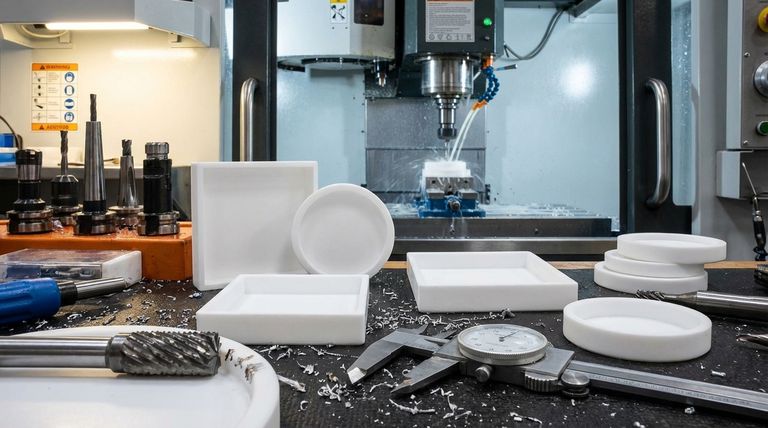Machining Teflon (PTFE) presents a unique paradox. While the material is exceptionally soft and easy to cut, achieving precision is remarkably difficult. The primary challenges stem from its low friction making it hard to secure, its tendency to deform under pressure, and its high thermal expansion which complicates holding tight tolerances.
The core challenge of machining Teflon is not cutting the material, but controlling it. Its softness, slipperiness, and thermal instability require specialized tools, careful workholding, and a deep understanding of its properties to prevent deformation and maintain dimensional accuracy.

The Workholding Challenge: Slippery and Soft
The initial and most fundamental problem with machining Teflon begins before the first cut is even made: securing the workpiece.
Low Coefficient of Friction
Teflon is famously slippery, which makes it incredibly difficult to grip securely in a vise, chuck, or fixture. Standard clamping pressures may not be enough to prevent the part from shifting during the machining process.
Deformation Under Pressure
The natural response to a slippery part is to increase clamping force. However, Teflon's softness means it will easily deform, compress, or "squish" under excessive pressure, ruining dimensional accuracy from the very start.
Achieving Precision with an Unstable Material
Teflon's physical properties actively work against the goal of maintaining tight tolerances throughout the machining process.
High Thermal Expansion
Teflon has a very high coefficient of thermal expansion. Even the minimal heat generated by a cutting tool will cause the material to expand significantly, and as it cools, it will contract. This thermal instability makes it a constant battle to hold precise dimensions.
Stress Creep (Cold Flow)
When placed under mechanical stress, such as clamping pressure, Teflon will slowly and permanently deform over time in a process known as stress creep or cold flow. Unlike metals, it does not spring back to its original shape, making it difficult for a part to hold its intended geometry.
Burr Formation
Because Teflon is so soft and ductile, it tends to form pushed-over burrs rather than clean, brittle chips. This requires extremely sharp tooling to minimize and often necessitates secondary deburring operations to achieve a clean final part.
Understanding the Inherent Trade-offs
Some challenges are not about technique but are fundamental limitations of the material that must be acknowledged.
Poor Dimensional Stability
The combination of high thermal expansion and stress creep means Teflon is inherently not a dimensionally stable material. It is unsuitable for applications where a component must hold an exact size and shape under varying temperatures or loads.
Low Mechanical Properties
Teflon is soft and has poor mechanical strength compared to other engineering plastics like Nylon. This is a core material property that cannot be changed through machining and must be considered during the design phase.
The Need for Specialized Tooling
Standard machine tools can struggle with Teflon. Success often requires custom carbide or even diamond cutters with very sharp edges and specific geometries designed to improve chip clearance and provide a clean shearing action rather than a pushing one.
Critical Safety Considerations
Beyond the machining challenges, working with Teflon requires strict adherence to safety protocols.
Thermal Decomposition
When Teflon is heated above 250°C (482°F), it begins to decompose and can release toxic gases. It is absolutely critical to control heat generation during machining to prevent this from occurring.
The Role of Coolant and Ventilation
Using a non-aromatic, water-soluble coolant is essential. Its primary role is to manage heat, preventing thermal expansion and keeping the workpiece well below the decomposition temperature. Proper ventilation is mandatory to ensure a safe working environment.
How to Apply This to Your Project
Your machining strategy must be dictated by the most critical outcome for your specific part.
- If your primary focus is tight tolerances: You must prioritize thermal management with coolants and account for the material's high coefficient of expansion in your measurements and programming.
- If your primary focus is surface finish: Use extremely sharp, specialized tools with high rake angles and clearance, combined with a steady coolant flow to prevent burrs and material sticking.
- If your primary focus is safety and consistency: Implement robust ventilation and strict temperature control to avoid thermal decomposition and ensure predictable part behavior.
Successful Teflon machining relies less on aggressive material removal and more on a meticulous, controlled approach that respects the material's unique limitations.
Summary Table:
| Challenge | Key Issue | Impact on Machining |
|---|---|---|
| Workholding | Low friction & softness | Part slippage & deformation under clamps |
| Precision | High thermal expansion & stress creep | Inability to hold tight tolerances |
| Safety | Thermal decomposition >250°C | Releases toxic fumes; requires coolant & ventilation |
| Tooling | Soft, ductile material | Burr formation; requires sharp, specialized tools |
Don't Let Teflon's Challenges Compromise Your Part Quality
Machining PTFE components to precise specifications requires expert knowledge and specialized tooling. KINTEK specializes in manufacturing high-precision PTFE seals, liners, and labware for the semiconductor, medical, laboratory, and industrial sectors. We understand the intricacies of Teflon's properties and employ controlled processes to ensure dimensional accuracy and a superior finish, from prototypes to high-volume production.
Contact KINTEK today to discuss your PTFE project and benefit from our precision manufacturing expertise.
Visual Guide

Related Products
- Custom PTFE Parts Manufacturer for Teflon Containers and Components
- Custom PTFE Parts Manufacturer for Teflon Parts and PTFE Tweezers
- Customizable PTFE Rods for Advanced Industrial Applications
- Custom PTFE Teflon Balls for Advanced Industrial Applications
- Custom PTFE Measuring Cylinders for Advanced Scientific and Industrial Applications
People Also Ask
- What is the hardness range of PTFE on the Shore D scale? Leveraging Its Softness for Superior Performance
- How is PTFE used in industrial processes? Maximize Safety and Efficiency
- When and by whom was PTFE discovered? A Tale of Accidental Innovation
- What is the temperature range that PTFE can withstand? From -200°C to +260°C for Demanding Applications
- Why is PTFE considered a significant discovery? A Material That Revolutionized Industry



















